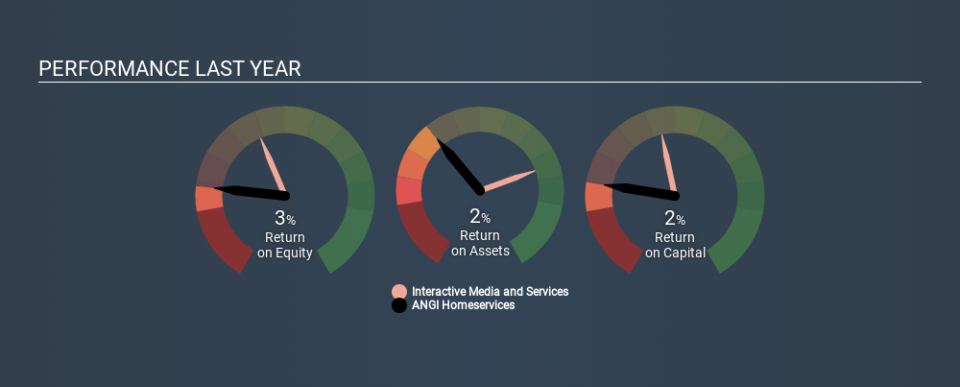ANGI Homeservices Inc.’s (NASDAQ:ANGI) Investment Returns Are Lagging Its Industry

Today we'll look at ANGI Homeservices Inc. (NASDAQ:ANGI) and reflect on its potential as an investment. Specifically, we'll consider its Return On Capital Employed (ROCE), since that will give us an insight into how efficiently the business can generate profits from the capital it requires.
First, we'll go over how we calculate ROCE. Then we'll compare its ROCE to similar companies. And finally, we'll look at how its current liabilities are impacting its ROCE.
Return On Capital Employed (ROCE): What is it?
ROCE measures the 'return' (pre-tax profit) a company generates from capital employed in its business. All else being equal, a better business will have a higher ROCE. In brief, it is a useful tool, but it is not without drawbacks. Author Edwin Whiting says to be careful when comparing the ROCE of different businesses, since 'No two businesses are exactly alike.
So, How Do We Calculate ROCE?
Analysts use this formula to calculate return on capital employed:
Return on Capital Employed = Earnings Before Interest and Tax (EBIT) ÷ (Total Assets - Current Liabilities)
Or for ANGI Homeservices:
0.023 = US$39m ÷ (US$1.9b - US$215m) (Based on the trailing twelve months to December 2019.)
So, ANGI Homeservices has an ROCE of 2.3%.
See our latest analysis for ANGI Homeservices
Does ANGI Homeservices Have A Good ROCE?
ROCE is commonly used for comparing the performance of similar businesses. Using our data, ANGI Homeservices's ROCE appears to be significantly below the 10.0% average in the Interactive Media and Services industry. This performance is not ideal, as it suggests the company may not be deploying its capital as effectively as some competitors. Putting aside ANGI Homeservices's performance relative to its industry, its ROCE in absolute terms is poor - considering the risk of owning stocks compared to government bonds. There are potentially more appealing investments elsewhere.
We can see that, ANGI Homeservices currently has an ROCE of 2.3%, less than the 11% it reported 3 years ago. So investors might consider if it has had issues recently. The image below shows how ANGI Homeservices's ROCE compares to its industry, and you can click it to see more detail on its past growth.
It is important to remember that ROCE shows past performance, and is not necessarily predictive. Companies in cyclical industries can be difficult to understand using ROCE, as returns typically look high during boom times, and low during busts. This is because ROCE only looks at one year, instead of considering returns across a whole cycle. What happens in the future is pretty important for investors, so we have prepared a free report on analyst forecasts for ANGI Homeservices.
What Are Current Liabilities, And How Do They Affect ANGI Homeservices's ROCE?
Short term (or current) liabilities, are things like supplier invoices, overdrafts, or tax bills that need to be paid within 12 months. The ROCE equation subtracts current liabilities from capital employed, so a company with a lot of current liabilities appears to have less capital employed, and a higher ROCE than otherwise. To counter this, investors can check if a company has high current liabilities relative to total assets.
ANGI Homeservices has total assets of US$1.9b and current liabilities of US$215m. As a result, its current liabilities are equal to approximately 11% of its total assets. This is not a high level of current liabilities, which would not boost the ROCE by much.
What We Can Learn From ANGI Homeservices's ROCE
That's not a bad thing, however ANGI Homeservices has a weak ROCE and may not be an attractive investment. You might be able to find a better investment than ANGI Homeservices. If you want a selection of possible winners, check out this free list of interesting companies that trade on a P/E below 20 (but have proven they can grow earnings).
If you are like me, then you will not want to miss this free list of growing companies that insiders are buying.
If you spot an error that warrants correction, please contact the editor at editorial-team@simplywallst.com. This article by Simply Wall St is general in nature. It does not constitute a recommendation to buy or sell any stock, and does not take account of your objectives, or your financial situation. Simply Wall St has no position in the stocks mentioned.
We aim to bring you long-term focused research analysis driven by fundamental data. Note that our analysis may not factor in the latest price-sensitive company announcements or qualitative material. Thank you for reading.

